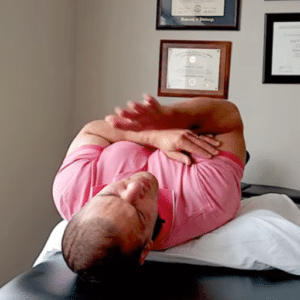Vertigo can be an alarming experience. Imagine waking up and suddenly feeling the room spinning around you. This type of vertigo can be extremely worrisome, but most of the time it's a benign issue called Benign Paroxysmal Positional Vertigo (BPPV) caused by misplaced crystals in the ear.
Watch the video to learn a vertigo home treatment called the Epley maneuver to quickly relieve dizziness and vertigo from misplaced inner ear crystals.
Vertigo From Crystals In Ear?
Understanding Benign Paroxysmal Positional Vertigo (BPPV)
Benign Paroxysmal Positional Vertigo (BPPV) is a type of vertigo characterized by sudden spinning sensations triggered by specific head movements.
It occurs due to the displacement of small calcium crystals within the semicircular canals of the inner ear. These crystals are known as otoliths.
The semicricular canals are vital for detecting rotational movements of the head. They play a crucial role in maintaining your balance and sense of equilibrium.
When these inner ear crystals become dislodged and move into the canals, they send your brain false signals about your head's position and movement.
As a result, your brain receives conflicting information. Your body and eyes are saying that you're stationary while your vestibular system (inner ear) is telling you that you're moving.
The best story that your brain can make up to explain this conflict is that you're staying still within the room and the whole room is moving.
What Causes BPPV?
While the exact cause of BPPV may not always be clear, several factors can contribute to its development:
- Head trauma: A blow to the head or a whiplash injury can displace the otoliths, leading to BPPV symptoms.
- Inner ear infections: Inflammation of the inner ear, often due to viral or bacterial infections, can disrupt the normal positioning of the otoliths.
- Aging: As we age, the structures of the inner ear can undergo changes, increasing the risk of BPPV.
- Meniere's disease: This inner ear disorder can sometimes be associated with BPPV.
- Prolonged bed rest: Staying in bed for an extended period, such as after surgery or illness, may cause the otoliths to shift.
Symptoms of BPPV
BPPV is characterized by brief episodes of vertigo triggered by specific head movements. Some common symptoms include:
- Sudden spinning sensation: Individuals experience a strong sensation of the surroundings spinning or moving around them.
- Positional triggers: BPPV is often brought on by changes in head position, such as rolling over in bed, getting up too quickly, or tilting the head.
- Short duration: Vertigo episodes in BPPV typically last for less than one minute and may resolve on their own.
- Repeated episodes: Individuals with BPPV may experience recurring episodes triggered by specific movements.
A Quick, Easy Vertigo Home Treatment: The Epley Maneuver
If you need a fast and effective vertigo home treatment, the Epley maneuver is a good option.
While it might not be as precise as when performed by a skilled clinician, the self-Epley maneuver can still be a good home treatment for vertigo in a pinch.
How to Perform the Epley Maneuver to Treat Vertigo at Home
To perform the Epley maneuver at home, follow these steps:
- Determine the Affected Ear: If you get dizziness or vertigo when you lie on your left side, the left ear is likely the affected one. If dizziness occurs when rolling over to the right side, the right ear is affected.
- Positioning: Place a pillow at shoulder blade level on the bed and lie down with your shoulder blades on the pillow. Keep your feet up on the bed.
- Head Orientation: Turn your head 45 degrees toward the affected ear.
- Lying down: Lay back quickly, allowing your head to rest on the bed while maintaining the 45-degree head turn.
- Wait for Dizziness to Subside: Hold this position for about 30 seconds to a minute until the vertigo sensations lessen.
- Change Head Orientation: Turn your head 45 degrees to the opposite side and hold this position for another 30 seconds to a minute.
- Roll Over: Roll over onto your side, with your head still turned slightly towards the floor.
- Return to a Sitting Position: Slowly push yourself up using your hand on the side of the bed, keeping your head looking downward towards the floor.
It is essential to perform the Epley maneuver carefully, especially if experiencing severe dizziness or vertigo. You get pretty close to the edge of the bed when doing it, and if you're already dizzy, you don't want to fall out of bed. Having someone nearby to assist can add an extra layer of safety and reassurance.
Conclusion
Vertigo caused by BPPV can be a concerning experience, but it is essential to remember that this condition is benign.
The Epley maneuver is quick and effective home vertigo treatment that can help relieve your dizziness by repositioning displaced crystals in your ear.
Although the home Epley maneuver can provide some relief, getting help from a skilled professional trained in treating vertigo often results in a faster and longer-lasting improvement in your symptoms.
Need Vertigo Treatment In St. Louis?
If you live in the St. Louis, MO area and need help for vertigo from BPPV, we'd be happy to help you at More 4 Life.
Just tap the button below to request an appointment with one of our specialist physical therapists.
Additionally, here are some other posts about balance that you might find helpful:
3 Best Balance Exercises For Seniors To Improve Balance At Home
Spinal Stenosis and Balance Problems:3 Ways To Improve Your Balance
Best Glute Strength Exercise Ever







